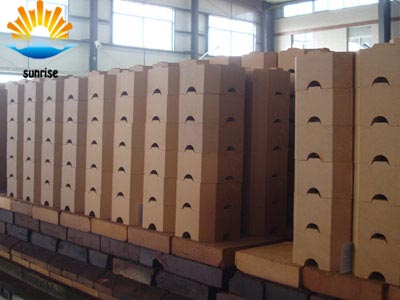Hot Product
Refractory Knowledge
Common causes of damage to refractory bricks
Date:2019-08-02 17:05 From:Zhengzhou Sunrise Refractory Author:admin
Refractory materials are subjected to high temperature, rapid temperature changes, atmospheric changes and erosion by dust, fumes, molten metal and slag during use. Therefore, it is very likely to be damaged, which makes it difficult for us to judge whether it is What caused the damage of the refractory bricks. Through a comprehensive analysis of the results of the use of refractory materials, the damage mechanism of refractory materials can be classified.
First, continuous erosion
1. Melting and gasification of the brick surface: interfacial reaction between the molten phase in the molten phase, the gas phase, and the gas phase and the brick.
2. Melting and gasification inside the brick: the melting and melting of the melt and the gas phase components, and the gasification components are discharged to the outside.
Second, discontinuous erosion
1. Cracking occurs:
A low-density phase, a phase shift accompanying a volume change, a local shrinkage and thermal stress concentration caused by reheating, a local concentration of bubbles, a structural mechanical stress, and a thermal stress concentration by reaction with a permeate Anisotropy of thermal stress and elastic modulus, precipitation deposition caused by gas phase reaction, mechanical impact.
2. The presence or formation of local high melting, high vapor pressure or low viscosity phase.
 Third, the loss caused by wear
Third, the loss caused by wear
The damage mode of refractory materials in use can be summarized into three basic forms.
1. The refractory work lining is damaged due to mechanical stress and thermal stress of the structure, resulting in irregular cracks (hot, mechanical peeling or falling off).
2. The structure of the refractory changes due to the slag infiltration and the temperature fluctuation on the hot surface (working surface), thus forming a characteristic metamorphic layer, and a crack parallel to the heating surface is formed at the interface between the original layer and the metamorphic layer. (Structural peeling) and damaged.
3. Dissolved and worn due to reaction with molten metal, slag and soot.
Refractory materials are actually thermodynamically unstable during use. Therefore, the direction of research and development of refractory materials is to establish a dynamic barrier within (and in the vicinity of) refractory materials to resist deterioration caused by ultimately irreversible structural and compositional changes.
If you want to know more about refractory bricks, please contact sunrise Refractory Company.
First, continuous erosion
1. Melting and gasification of the brick surface: interfacial reaction between the molten phase in the molten phase, the gas phase, and the gas phase and the brick.
2. Melting and gasification inside the brick: the melting and melting of the melt and the gas phase components, and the gasification components are discharged to the outside.
Second, discontinuous erosion
1. Cracking occurs:
A low-density phase, a phase shift accompanying a volume change, a local shrinkage and thermal stress concentration caused by reheating, a local concentration of bubbles, a structural mechanical stress, and a thermal stress concentration by reaction with a permeate Anisotropy of thermal stress and elastic modulus, precipitation deposition caused by gas phase reaction, mechanical impact.
2. The presence or formation of local high melting, high vapor pressure or low viscosity phase.

The damage mode of refractory materials in use can be summarized into three basic forms.
1. The refractory work lining is damaged due to mechanical stress and thermal stress of the structure, resulting in irregular cracks (hot, mechanical peeling or falling off).
2. The structure of the refractory changes due to the slag infiltration and the temperature fluctuation on the hot surface (working surface), thus forming a characteristic metamorphic layer, and a crack parallel to the heating surface is formed at the interface between the original layer and the metamorphic layer. (Structural peeling) and damaged.
3. Dissolved and worn due to reaction with molten metal, slag and soot.
Refractory materials are actually thermodynamically unstable during use. Therefore, the direction of research and development of refractory materials is to establish a dynamic barrier within (and in the vicinity of) refractory materials to resist deterioration caused by ultimately irreversible structural and compositional changes.
If you want to know more about refractory bricks, please contact sunrise Refractory Company.
Inquiry:
If you have any questions or good suggestions on our products and site, or if you want to know more information about our products, please write them and send to us, a representative will contact you within one business day. We guarantee that your information will not be divulged to the third party.

